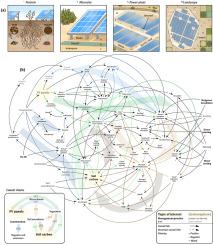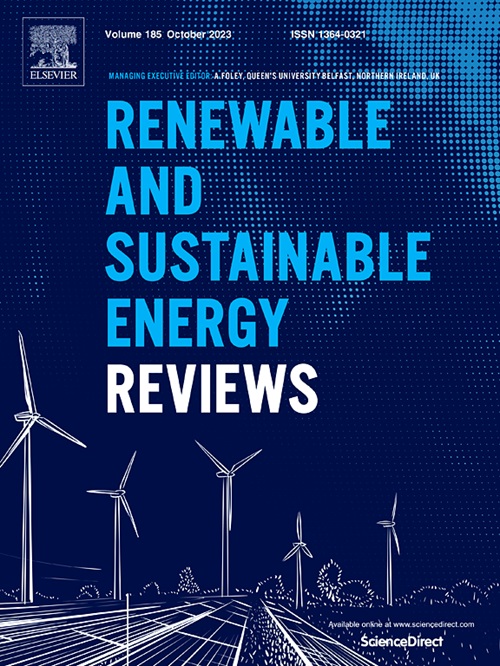Impacts of photovoltaic solar energy on soil carbon: A global systematic review and framework
IF 16.3
1区 工程技术
Q1 ENERGY & FUELS
引用次数: 0
Abstract
Globally, solar energy is anticipated to be the primary source of electricity as early as 2050, and the greatest additions in capacity are currently in the form of large, ground-mounted photovoltaic solar energy facilities (GPVs). Growing interest lies in understanding and anticipating opportunities to increase soil carbon sequestration across the footprint and perimeter of both conventional and multi-use GPVs (e.g., ecovoltaics, agrivoltaics, and rangevolatics), especially as operators increasingly deputize as land managers. To date, studies on the relationship between soils and PV solar energy are limited to unique, localized sites. This study employed a systematic review to (i) identify a global corpus of 18 studies on interactions between GPVs and soils, (ii) collect and characterize 113 soil and soil-related experimental variables interacting with GPVs from this corpus, and (iii) synthesize trends among these experimental variables. Next, this study combined data from the systematic review with an iterative, knowledge co-production approach to produce a conceptual model for the study of soil and GPV interactions that applies to multiple installation types, scales, and contexts where GPVs are deployed, and identified research opportunities, threats, and priorities. This study's baseline understanding, conceptual model, and co-produced knowledge confer unique insight into the feasibility of combining soil carbon sequestration with the climate change mitigation potential of PV solar energy.

光伏太阳能对土壤碳的影响:全球系统性审查和框架
在全球范围内,预计太阳能最早将在 2050 年成为主要的电力来源,而目前最大的新增发电量是大型地面光伏太阳能设施(GPV)。人们对了解和预测在传统和多用途 GPV(如生态光伏、农业光伏和牧场光伏)的占地面积和周边地区增加土壤固碳的机会越来越感兴趣,特别是当运营商越来越多地成为土地管理者的时候。迄今为止,有关土壤与光伏太阳能之间关系的研究仅限于独特的局部地点。本研究采用了系统性回顾的方法:(i) 识别全球 18 个关于 GPV 与土壤之间相互作用的研究语料库;(ii) 从这些语料库中收集 113 个与 GPV 相互作用的土壤和土壤相关实验变量并描述其特征;(iii) 综合这些实验变量之间的趋势。接下来,本研究将系统综述的数据与迭代、知识共同生产的方法相结合,为土壤与 GPV 的相互作用研究建立了一个概念模型,该模型适用于多种安装类型、规模和 GPV 部署的环境,并确定了研究机会、威胁和优先事项。这项研究的基线认识、概念模型和共同生产的知识,为将土壤固碳与光伏太阳能的气候变化减缓潜力相结合的可行性提供了独特的见解。
本文章由计算机程序翻译,如有差异,请以英文原文为准。
求助全文
约1分钟内获得全文
求助全文
来源期刊

Renewable and Sustainable Energy Reviews
工程技术-能源与燃料
CiteScore
31.20
自引率
5.70%
发文量
1055
审稿时长
62 days
期刊介绍:
The mission of Renewable and Sustainable Energy Reviews is to disseminate the most compelling and pertinent critical insights in renewable and sustainable energy, fostering collaboration among the research community, private sector, and policy and decision makers. The journal aims to exchange challenges, solutions, innovative concepts, and technologies, contributing to sustainable development, the transition to a low-carbon future, and the attainment of emissions targets outlined by the United Nations Framework Convention on Climate Change.
Renewable and Sustainable Energy Reviews publishes a diverse range of content, including review papers, original research, case studies, and analyses of new technologies, all featuring a substantial review component such as critique, comparison, or analysis. Introducing a distinctive paper type, Expert Insights, the journal presents commissioned mini-reviews authored by field leaders, addressing topics of significant interest. Case studies undergo consideration only if they showcase the work's applicability to other regions or contribute valuable insights to the broader field of renewable and sustainable energy. Notably, a bibliographic or literature review lacking critical analysis is deemed unsuitable for publication.
 求助内容:
求助内容: 应助结果提醒方式:
应助结果提醒方式:


